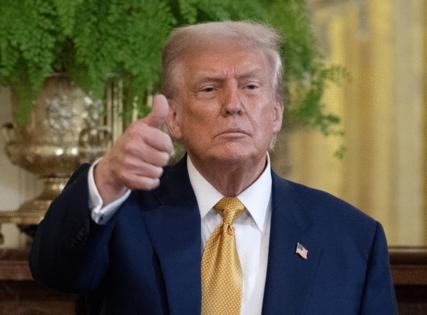Trump and Von Der Leyen to meet with trade deal in balance
Published in News & Features
European Commission President Ursula von der Leyen will meet President Donald Trump on Sunday in a bid to reach a trade agreement ahead of Friday’s deadline, at which point 30% tariffs on the bloc’s exports to the U.S. are otherwise due to kick in.
The stakes for the talks, scheduled for 4:30 p.m. local time at Trump’s golf resort in Turnberry, western Scotland, could hardly be higher for von der Leyen. Yet after months of talks and shuttle diplomacy, finalizing a deal hinges mostly on Trump.
Approached by Sky News while golfing on Sunday, Trump repeated his recent assessment that the chances of a deal with the EU are “50-50.”
EU ambassadors, who’ve been on a visit to Greenland this weekend, are expected to be briefed ahead of the meeting. EU officials have repeatedly cautioned that an agreement ultimately rests with Trump, making the outcome hard to predict. The U.S. president recently negotiated with Japan and appeared to change certain final terms on the fly before an agreement was eventually agreed upon.
“Intensive negotiations at technical and political have been ongoing,” said Paula Pinho, the commission president’s spokesperson. “Leaders will now take stock and consider the scope for a balanced outcome that provides stability and predictability for businesses and consumers on both sides of the Atlantic.”
The EU and U.S. have been zeroing in on an agreement that would see the EU face 15% tariffs on most of its trade with the U.S. Limited exemptions are expected for aviation, some medical devices and generic medicines, several spirits, and a specific set of manufacturing equipment that the U.S. needs, Bloomberg previously reported.
Steel and aluminum imports would likely benefit from a quota under the arrangements under discussion, but above that threshold they would face a higher tariff of 50%.
U.S. Commerce Secretary Howard Lutnick said it’s up to the EU to persuade Trump.
“The question is, do they offer President Trump a good enough deal that is worth it for him to step off of the 30% tariffs that he set,” he said in a "Fox News Sunday" interview broadcast Sunday.
Alongside a universal levy, the U.S. president has hit cars and auto parts with a 25% levy, and steel and aluminum with double that. He’s also threatened to target pharmaceuticals and semiconductors with new duties as early as next month, and recently announced a 50% tariff on copper.
The EU is expecting the same 15% ceiling on some sectors that could be the target of future tariffs, including pharmaceuticals, according to people familiar with the matter. But that’s one of the key points where Trump’s position will be crucial to a deal being sealed, the people added.
“We’ll see if we make a deal,” Trump said as he arrived in Scotland on Friday. “Ursula will be here, highly respected woman. So we look forward to that.”
Trump reiterated that he believed there’s “a 50-50 chance” of a deal with the EU, saying there were sticking points on “maybe 20 different things” that he didn’t want to detail publicly.
Trump gave similar chances of an agreement before leaving Washington, but also said the EU had a “pretty good chance” of reaching a deal.
The U.S. president announced tariffs on almost all U.S. trading partners in April, declaring his intent to bring back domestic manufacturing, pay for a massive tax-cut extension, and stop the rest of the world from — as Trump has characterized it — taking advantage of the U.S.
Lutnick said there’s no wiggle room on the administration’s latest deadline of Aug. 1 for deals to avoid or lower those levies, though Trump is ready to keep negotiating after that date.
“No extensions, no more grace periods,” Lutnick said on Fox News. “August 1, the tariffs are set, they’ll go into place.”
In addition to levies, any agreement would cover non-tariff barriers, cooperation on economic security matters, and strategic purchases by the EU in sectors such as energy and artificial intelligence chips, Bloomberg previously reported. The bloc has also offered to remove tariffs on many industrial goods and non-sensitive agricultural imports.
The terms of any initial deal, which is likely to take the form of a short joint statement if agreed upon, would need to be approved by member states, some of the people said. And a statement would be seen as a stepping stone toward more detailed talks.
Because of the ongoing uncertainty, the EU has in parallel sketched out countermeasures in the event of a no-deal scenario. That would see it quickly hit American exports with up to 30% tariffs on some €100 billion ($117 billion) worth of goods — including Boeing Co. aircraft, US-made cars and bourbon whiskey — in the event of no deal is reached, or if Trump carries through with his threat to impose that rate on most of the bloc’s exports after Aug. 1 or in future. The package also includes some export restrictions on scrap metals.
Absent a deal, the bloc is also prepared to move forward with its anti-coercion instrument, a potent tool that would eventually allow it to target other areas such as market access, services and restrictions on public contracts, provided a majority of member states backs its use.
While Trump didn’t explicitly link negotiations to non-trade matters on Friday, he suggested that he planned to raise concerns over migration flows. Trump has imposed strict anti-immigration policies since returning to office, carrying out a mass deportation effort of those in the U.S. illegally while also narrowing pathways to legally move to the U.S.
“You got to stop this horrible invasion that’s happening to Europe, many countries in Europe,” Trump said, adding that he believed “immigration is killing Europe.”
_____
(With assistance from Josh Wingrove and Hadriana Lowenkron.)
_____
©2025 Bloomberg L.P. Visit bloomberg.com. Distributed by Tribune Content Agency, LLC.







Comments